
Since 1979, the S&P 500 has gained 10% or more 14 times during the first half of the year.
Michael Nagle/BloombergThe S&P 500 closed its second-best first half since the dot-com bubble. Don’t be surprised if the stock market keeps on rising.
With June coming to an end, the S&P 500 finished the first half of 2021 with a gain of 14.4%. Since 1998, only 2019’s 17.4% first-half surge has been larger.
The market got a boost from Covid-19 vaccinations, which have helped the U.S. economy reopen, while trillions of dollars of fiscal stimulus have helped shore up demand. The gains continued even as concerns about inflation have increased speculation that the Federal Reserve would be forced to take steps to slow the economy.
The combination of big gains and a more hawkish Fed have raised concerns that the market has become too complacent. If inflation continues to run hot for long enough, the central bank could be forced to act more quickly than the market expects—and cause stocks to tumble. Others worry that U.S. economic growth could slow faster than investors anticipate, causing a pullback in the process.
For those who take that view, there is no better time to back away from the stock market than the present. History suggests otherwise.
Since 1979, the S&P 500 has gained 10% or more 14 times during the first half of the year, and the index has gone on to average a 6.3% gain over the second half of the year. What’s more, the index finished the second half of the year higher In 11 of those instances, or 79% of the time.
Even the losses, when they occurred, weren’t all that bad. The S&P 500 dropped 1.9% in the second half of 1983 and 3.5% during the last six months of 1986.
The one exception was the last six months of 1987 when the index fell 19% during the second half of the year. That period included Black Monday, when the S&P 500 dropped 20% in one day, still a record loss. While selling linked to so-called portfolio insurance was ultimately blamed for the size and speed of the loss, the second half of 1987 was a period of rising bond yields and high stock-market valuations, just like the first half of 2021.
Still, the market has been acting like it wants to go higher, not lower. Pullbacks, a normal event in the midst of bull runs, have been mild in 2021, with the largest drops being less than 4%. “What the [S&P 500] has done throughout 2021 is pick itself up when and where it has needed to, maintaining an uptrend all along,” writes Frank Cappelleri, chief market technician at Instinet.
That 6.3% average second-half rise would push the S&P 500’s full-year gain to around 23%. That would represent a “textbook [market] recovery” from a recession, says Fundstrat’s Tom Lee.
For now, at least, the path of least resistance is higher.
Write to Jacob Sonenshine at jacob.sonenshine@barrons.com
"stock" - Google News
July 01, 2021 at 03:02AM
https://ift.tt/3hrhNhp
Is the Stock Market Headed for a Crash After Its Second-Best First Half Since 1998? What's Next. - Barron's
"stock" - Google News
https://ift.tt/37YwtPr
https://ift.tt/3b37xGF
Bagikan Berita Ini














0 Response to "Is the Stock Market Headed for a Crash After Its Second-Best First Half Since 1998? What's Next. - Barron's"
Post a Comment